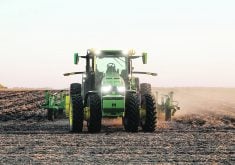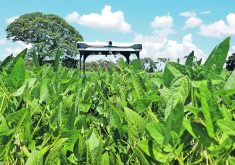LAS VEGAS, Nev. — Autonomous tractors attract farmers like flies to … well, you know.
Not only do farmers like tractors, but they like work that is done reliably and repeatedly, something that is not always available in the labour market.
“And when it is dangerous, dirty or dull, that is when autonomous ma-chines really kick in,” said Omar-Pierre Soubra, grasping and rubbing out a handful of desert clay and sand in a construction yard at the edge of the Nellis Airforce Base in Nevada last month.
Read Also

Growing garlic by the thousands in Manitoba
Grower holds a planting party day every fall as a crowd gathers to help put 28,000 plants, and sometimes more, into theground
Farmers get dirty, plants and livestock love dull and farming is one of the most dangerous businesses going, so Soubra feels he has found a match when it comes to pairing robotics and tractors.
Soubra works for the technology company Trimble and was demonstrating its version of an autonomous farm tractor at the company’s annual Dimensions event, which highlights what the company and its partners are working on and where it believes the world is headed when it comes to guidance and remote data handling.
Trimble has been in the farm guidance game since the early 2000s, giving it a boot up when it comes to building fully autonomous machinery.
In fact, other companies that offer those solutions often use Trimble ingredients in the technology stews that form many of the robotic meals.
Major companies are pushing the automation agenda, likely hoping to get past any social license or regulatory hurdles with a quick movement into farmers’ fields, while at the same time carving out a market niche that many, including producers, feel is overdue for innovation.
Case IH, sister New Holland, Agco via Fendt, Deere and Kinze have all toyed with farmers’ desires for autonomous machinery in the past few years.
The company took some of its “off the shelf” pieces and built its own robotic tractor based on a Case IH Puma 150 CVT.
Most farmers adopted passive guidance 15 to 20 years ago, while active steering control has been in place for more than a decade on most farms.
“The same technology could be in much larger tractors, or combines or forage machinery,” he said.
“We are working right now to understand all of the issues related to it, the way a farmer uses it and what else they might want it to do,” he said.
The demonstration tractor’s existing steering and shifting controls were “high-jacked” through the CANBUS connection.
All the operating information from the machine, such as operating oil pressure, fuel levels, engine, transmission and hydraulic temperatures, are fed back to a remote computer and mobile tablet via cellular connections through the existing Trimble telematics software. It’s all part of a full farm package now known as Trimble Ag.
The additions to the system are an array of antennas that allow for enhanced connectivity to other systems, including an emergency stop tool, and sensors not found on a manned tractor.
One of the main tools that takes the Trimble, and most other autonomous machines, from semi to fully automatic is an active awareness system like LIDAR.
It looks for changes in surroundings that are unexpected and match predictable shapes and concepts that are programmed into the machines.
John Peake, who manages the engineering that supports the autonomous tractor project at Trimble, said the auto industry is playing a big role in his company’s choice to head into the uncharted market.
Trimble worked with San Francisco’s OTTO on the self-driving semi tractor trailer unit that earlier this fall hauled a truckload of beer 200 kilometres from the Budweiser plant in Fort Collins, Colorado, to Colorado Springs, Colorado.
The machine didn’t have to navigate more than an interstate highway, but it needed to manage freeway traffic.
It used three LIDAR units on the cab, along with a high definition camera and a radar unit on the front bumper and the now ubiquitous GPS antenna on the roof.
“The cost of the most expensive sensors needed for agricultural applications is falling really quickly due to the use of them in the auto and consumer industries,” said Peake.
“That makes it more affordable for agriculture and things are starting to move very quickly in farming as a result.”
The Trimble equipped tractor was able to move easily around an obstacle course set out for it, while adapting to unplanned events. The machine was capable of slow and fast transits of the desert course.
“We aren’t quite ready for prime time, yet but are closer than anyone might have imagined only a year or two ago,” he said, alluding to a manual shut down that was necessary while American farm journalist Willie Vogt was riding in the tractor during the Nevada demonstration.
Joe Michaels of Case IH said most of the technology needed to create a fully autonomous tractor or combine is already in the machinery.
“Safety in the field is the main part of the technology that needs to be understood before the equipment is headed to the field,” he said.
“Lots of farmers are telling us they are ready, especially up in Western Canada and the northern Plains.”
Case IH unveiled a cabless Magnum tractor at an Iowa farm show in September. Michaels said the company was looking for input from producers that it could use to further development and commercialization.
Peake said the issue of transporting machinery on the public road systems remains a challenge but feels acceptance of that will come along with driverless cars.

















